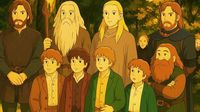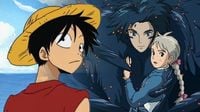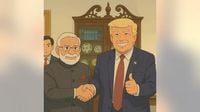In a whirlwind of creativity and controversy, millions of users worldwide have embraced the latest trend of transforming their personal images into Studio Ghibli-style art using OpenAI’s GPT-4o. This new image generation feature has gone viral, captivating both celebrities and everyday users alike, as they flood social media with their Ghibli-inspired portraits and scenes. However, this trend has sparked a heated debate over copyright violations and the potential devaluation of human artistry.
As the digital landscape becomes increasingly populated with AI-generated images, concerns about artistic integrity have been raised. Critics argue that the trend diminishes the value of traditional art forms and exploits the unique styles of established artists. Among the most vocal critics is Megumi Ishitani, director of popular anime series like One Piece and Dragon Ball Super, who took to social media to express her frustration. On April 2, 2025, she stated, "I want legal action to be taken... I can't stand seeing Ghibli treated so cheaply." Her comments reflect a growing sentiment among creatives who feel that AI tools are undermining the hard work and dedication that goes into producing art.
Despite the backlash, the trend shows no signs of slowing down. The integration of an advanced image generator into GPT-4o has led to an explosion of Ghibli-style images, with users creating everything from whimsical family portraits to elaborate memes. Celebrities, including India’s Prime Minister Narendra Modi, have joined the fray, sharing Ghibli-style portraits of world leaders like Donald Trump and Emmanuel Macron. This widespread participation has only fueled the debate about whether these AI creations constitute a form of artistic theft.
In response to the growing concerns, the moderators of the Ghibli subreddit, r/Ghibli, have enforced a strict ban on AI-generated art, emphasizing their commitment to protecting the integrity of Studio Ghibli’s unique style. One moderator noted, "We don’t allow AI art. We haven’t allowed it basically since it became a thing." This stance highlights a clear division between fans who view AI recreations as homage and those who see them as exploitation.
Hayao Miyazaki, the legendary director behind many of Studio Ghibli’s beloved films, has long been critical of AI-generated content. In a 2016 documentary, he expressed his disdain for AI animation, stating, "I can’t watch this stuff and find it interesting. Whoever creates this stuff has no idea what pain is whatsoever. I am utterly disgusted." His words resonate with many artists who worry that AI tools could threaten their livelihoods.
Legal experts are also weighing in on the issue. Intellectual property lawyer Robert Greener suggests that the AI tools are akin to an individual creating animation that emulates the Studio Ghibli style without consent. This raises questions about copyright infringement and whether AI-generated art can be legally protected. A recent ruling indicated that AI-generated art without human input cannot be copyrighted under U.S. law, leaving a gray area regarding the legality of Ghibli-style images.
OpenAI has acknowledged the concerns surrounding copyright and artistic integrity. The company stated that it is implementing safeguards to prevent its AI from closely mimicking the styles of living artists. However, as the technology continues to evolve, the effectiveness of these measures remains in question.
As the conversation around AI in art continues, many artists and fans are advocating for a balance between technological innovation and the preservation of artistic authenticity. While AI-generated art offers new opportunities for creativity, it also poses significant ethical challenges that cannot be ignored.
For those eager to join the Ghibli art trend without relying solely on ChatGPT, several free online tools can help users create their own Ghibli-style images. Options include platforms like Deep Dream Generator, Prisma, Grok, LunaPic, PhotoFunia, BeFunky, Fotor, and Flux. Each of these tools offers unique features that allow users to modify their photos in the enchanting style of Studio Ghibli.
Deep Dream Generator, for instance, utilizes neural networks to transform ordinary images into dreamy visuals reminiscent of Ghibli films. Users can upload their photos and select the desired style, adjusting the depth of the effect to achieve the perfect balance. Meanwhile, Prisma is a popular mobile app that offers artistic filters inspired by renowned artists, enabling users to recreate their photos as hand-painted images.
Grok, owned by xAI, provides a chatbot that can generate images from scratch or reimagine existing ones in various styles. With its integration into X (formerly Twitter), Grok has become a go-to tool for quick and easy Ghibli-style transformations. Other platforms like Fotor and Flux offer user-friendly interfaces and a range of filters that can add a soft glow or painterly feel to images.
As the popularity of Ghibli-style images continues to rise, users are encouraged to exercise caution when uploading personal photos to online AI tools. While many platforms claim to prioritize user privacy, not all adhere to stringent data protection standards. Users should carefully review privacy policies and avoid uploading sensitive images, particularly those involving minors.
In conclusion, the intersection of AI technology and art presents a complex landscape filled with both exciting possibilities and ethical dilemmas. As the Ghibli art trend captures the imagination of millions, it serves as a reminder of the importance of respecting artistic integrity while embracing innovation. The ongoing dialogue between traditional artists and AI advocates will shape the future of creativity, ensuring that the legacy of iconic studios like Ghibli remains intact.








